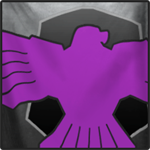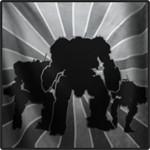1. Armor Section
--1.1. Armor Value
--1.2. Meta-Sections
--1.3. Sub-Sections
----1.3.1. Destroyed Sub-Sections Influence on Adjacent Sub-Sections
--1.4. Armor Weight Accommodation for Pelvis Section
2. Internal Equipment Modeling
--2.1. Internal Structure, Myomers, and Actuators
--2.2. Weapons
--2.3. Equipment
--2.4. Modeling Internal Hitbox Damage and Structural Damage
----2.4.1. Destruction of Internal Equipment Which Occupies More Than One Sub-Sections
--2.5. Technical Feasibility
3. Penetration
4. Conclusion
-------------------------------------------------------
► 1. Armor Sectioning
One of the single largest failures of TT rules translation has come in the form armor sectioning. In the TT game there are rules which universally dictate the chance to hit a particular section of a mech. In the video games mechs which have hitboxing issues can be unfairly buffed or nerfed depending on the ease or difficulty of hitting a particular section.
Examples include Mw4's Templar, Zeus, and Black Knight mechs. The Templar and Zeus both suffered from having outlandishly large side torso hitboxes while the Black Knight's center torso was enormous and disproportionate.
Some mechs were buffed by the hitboxing and ended up tougher than they probably should have been like the Mauler and Bushwhacker.
Additionally, the TT armor sections covered huge portions of mechs which, when considering the parts which took damage, caused a lot of visual confusion in the damage applied.
For instance, why would shooting an Atlas in the forehead and shooting an Atlas in the crotch both damage the center torso? The space between these two points is larger than some of the smaller mechs!
▼ 1.1. Armor Value
The following concepts are based on interpreting TT armor values in a different way. Or to be more precise, how those values are applied to a particular section in different way.Moving forward from this section I will predicate the following on the basis of armor value being a function of thickness rather than a catch-all hitpoint pool though as you read on you'll see I haven't deviated much from the traditional armor sectioning and armor values as one might think.
▼ 1.2. Meta-Sections
Meta-Sections are the traditional 11 armor sections plus one major addition: the pelvis section. Meta-sections would now be an "administrative" grouping that serve no other purpose but to define the armor value of sub-sections contained therein.Basically, this armor section classification exists to keep armor customization, if we even have any, relatively easy.
▼ 1.3. Sub-Sections
Sub-sections are exactly what they sound like: sections within sections; sections inside of a meta-section, to be precise.Remember when I said to think of sectional armor values as a thickness rather than a lump sum? That's because each sub-section maintains the full armor value of it's meta-section's amor value.
For instance, if an Atlas' leg has 41 points of armor on it than that value will now become the armor thickness for the leg meta-section.
Each invididuval sub-section of a meta-section will inherit the full armor value of the meta-section's listed thickness.
If we took that Atlas' leg and broke it into four sub-sections all of the sub-sections will have an armor value of 41.
This does not mean, however, that the armor from the leg's four sub-sections would quadruple the weight of the traditional leg armor.
But what would all of this look like? Using the concept art for the Atlas I've roughly modeled a large portion of what the Atlas' armor could look like using the meta/sub armor system.
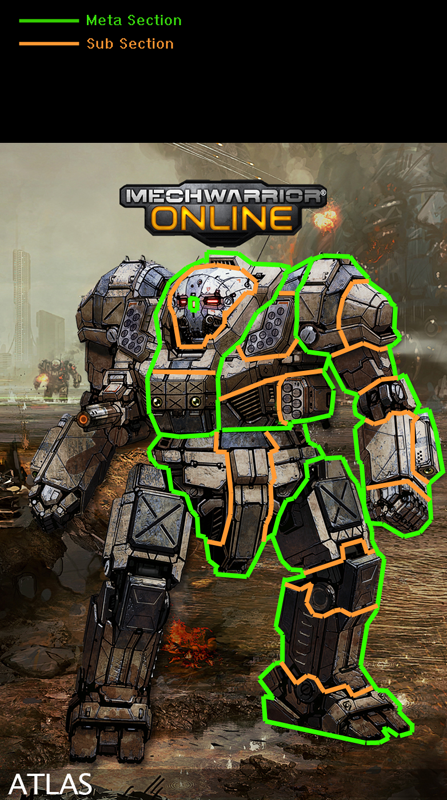
A mockup of the meta/sub-section armor model.
Please bear in mind that sub-section distribution is relatively arbitrary. The quantity of sub-sections per meta-section can be difficult to define. Do all mechs receive an equal amount of sub-sections per meta-section? Should a sub-section be defined by a rough yet pre-defined size so that larger mechs have more than smaller mechs?
These are questions I don't know the answer to. Again, this is something that obviously needs play-testing.
▼ 1.3.1. Destroyed Sub-Sections Influence on Adjacent Sub-Sections
This only makes sense to me for limbs since the torso is really a single solid object with a contiguous frame but destroying a sub-section would render everything "below" it completely inoperable/non-functioning.For a quick example, looking at the picture above one could imagine that completely destroying the bicep sub-section would server the arm at that point, or destroying the shin section of the leg would take the foot with it, et cetera.
The new pelvis section leaves a lot to think about. Would destroying the right pelvis section cost the mech it's leg? Should it? Would that be fun or frustrating?
I personally believe play-testing is the solution to that.
▼ 1.4. Armor Weight Accommodation For Pelvis Section
With the addition of a pelvic section to mechs and it's associated armor the weight of all other sections' armor must be reduced to compensate for the addition of the weight added by the pelvis armor.Using an AS7-D as my example the total weight of the armor for the traditional TT sections is 19 tons for a total of 304 armor points. This means each individual point of standard armor weighs exactly 0.0625 tons (19/304=0.0625).
If we add a pelvis and give it an armor value of 32, which matches the side torso though I'm being arbitrary, we'd be adding 2 additional tons of armor for a total of 21 tons of standard armor. We need to reduce this weight by 2 tons to maintain the original armor weight.
The total armor value of the Atlas with the pelvis armor hitpoints is raised to 336.
336x=19, where x is the weight of each individual point of armor. Using some simple algebra we can simply divide 19 by 336 for ~0.05655.
1 point of armor now weighs ~0.05655 tons. Obviously this can be increased or decreased in the name of a more simple weight-per-point value.
Of course, all of this assumes the canon armor values would be maintained. This may or may not be the case and if not this entire section is completely moot.
► 2. Internal Equipment Modeling
Up until now all internal equipment damage has been modeled through a random number generator or simple internal damage calculations (i.e. internal structure reduced by 50% and all equipment inside is considered destroyed).
Mw4 began to somewhat address this, at least with weapons, in the form of the S1 and S2 weapon sections. An example of them would be the Mad Cat's two shoulder mounted missile boxes. They were not part of the side torso but independent hitboxes which could be destroyed.
MWO needs to go one further and start to include internal hitboxes which model all internal stuctures and equipment. This means that if a section is stripped of armor or an attack penetrates armor it's not some RNG which dictates that component X or weapon Y is destroyed, it's whether or not that shot continued on it's trajectory to actually strike an internal hitbox meant to represent something like a gyro, weapon, or actuator.
▼ 2.1. Internal Structure, Myomers, and Actuators
Internal structure will function as it always has: as a hitpoint pool that can only be damaged after the armor pool has been depleted. Depletion of structure integrity will destroy that section and everything inside of it.Myomers are a mech's muscles. Destruction of myomers will reduce the movement speed of the limb they reside in.
Actuators are joints. For the sake of gameplay I'd make actuator destruction simply freeze that joint solid. I suppose you could have actuator destruction allow the joint to swing freely though that could get complicated with legs
I feel like this would be definitely be a play-testing issue to determine what is or isn't frustrating to a player.
But how would these systems be internally modeled? Below is a quick mock-up of what an Atlas' right leg could look like (forgot to put some myomer in the foot, oops!).
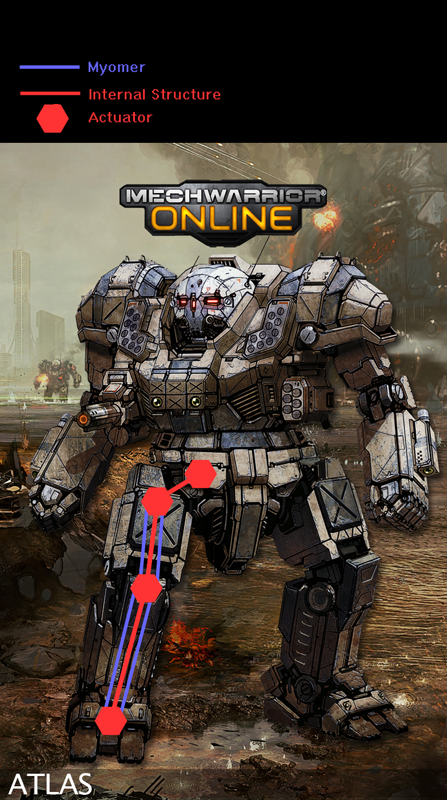
A mockup of internal structure, myomers, and actuators.
▼ 2.2. Weapons
As you may have seen in the first photo, which went over armor sections, all weapons are either independently modeled as their own sub-section (like the LRM launcher or SRM launcher) or grouped with a sub-section (like the two center torso mounted Medium Lasers or the left arm mounted Medium Laser).Depending on the artwork some weapons might be modeled as a sub-section though if the section they're attached to is destroyed the weapon sub-section would be destroyed as well. A good example of this would be the arm mounted medium lasers on the Atlas.
Though they can be destroyed independently of the forearm the forearm cannot be destroyed independently of the lasers. Destruction of the forearm means destruction of the lasers.
This is very similar to Mw4's S1 and S2 sections which were arm mounted. For instance, the flamer hitbox on the Uziel's right arm. It could be destroyed independently of the arm leaving the arm and everything inside it intact though if the arm was destroyed that flamer section was also destroyed.
▼ 2.3 Equipment
Like weapons equipment such as heatsinks, targeting computers, engines, gyros, and so forth need to be physically modeled inside of the mech as internal hitboxes.For the sake of easy display I have created "heatsink pods" in the various mech sections. These pods would allow multiple heat sinks to utilize the same internal hitbox.
In other words, if the left leg of an Atlas had two heat sinks in it they would share the same hitbox. I didn't think tracking individual heat sinks was worthwhile enough to be modeled.
Please keep in mind that in the picture below I've placed the engine's heatsinks arbitrarily.
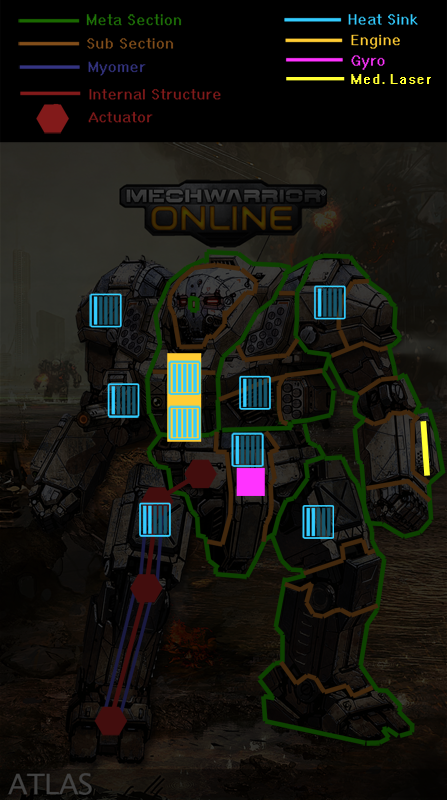
NOTE: Center torso mounted medium lasers are not shown due to the engine graphic.
▼ 2.4. Modeling Internal Hitbox Damage and Structural Damage
Internal hitboxes' hitpoint pools can only be damaged once the armor covering them is depleted or an attack penetrates and damage is transferred. Once an equipment hitbox is destroyed all further damage to that hitbox is transferred directly and fully to the sub-section's internal structure hitpoint pool.▼ 2.4.1. Destruction of Internal Equipment Which Occupies More Than One Sub-Section
This really only relates to the engine but obviously any internal equipment hitbox can be fully destroyed through a single sub-section so long as that internal hitbox receives enough damage to destroy it.▼ 2.5. Technical Feasibility
Some posters may argue the technical feasibility of the above but World of Tanks' damage modelling is just as, if not more, robust than what I'm proposing. WoT tracks the armor thickness of every piece of surface on a tank. Additionally, it internal models with hitboxes engines, transmissions, radios, commander's viewports, the weapon, the turret ring, ammunition, both tracks, fuel tanks, as well as each individual crew member (up to 6 I believe).Additionally, each component listed above may have more than one hitbox.
► 3. Penetration (Revised: 02 DEC 2011)
BT/MW has always used an ablative armor model. Critical hits have been the TT's solution to penetration but they're completely RNG based which bugs me. RNG-based elements remove skill by putting facets of gameplay beyond a player's control.
I'm not a fan.
What I've been thinking about lately is perhaps giving some weapons penetration. I say some because many weapons have absolutely no penetrative power like lasers. They can't bypass armor and transfer damage to stuff underneath because they're melting armor with heat. They must burrow fully through the armor before they can begin to damage what lies beneath.
I think there's some weapons which should be able to penetrate and I'm looking at ballistics because it would be a way to compensate them for inefficient space consumption, weight, ammunition, and ammunition explosions.
So what I would propose to start with is allowing ballistic weapons, in our case just autocannons, to fully penetrate armor when their armor value is less than the damage of the autocannon's round striking it.
I'm basing this off the "cassette" method of autocannons as they are described in source material and novels.
A quick explanation of the "cassette" style autocannons is that each TT "shot" is actually a 5-round burst. These 5 rounds are loaded into a "cassette" and that "cassette" is loaded into the AC. The AC can fire automatically and pilots have full control over how many rounds they can expend per trigger squeeze.
All 5 rounds in the cassette constitute a single TT shot from that weapon. This means that the "per bullet" ammo count for each AC would be multiplied by 5.
Once the cassette is depleted it's ejected and a new one is loaded.
Rules
-Rounds Per Cassette: 5 (for all AC calibers)
-Penetration = The amount of armor that the AC can completely defeat and bypass.
-Damage increased +25% from TT values
What's Not Taken Into Account
-Rate of fire for rounds in a cassette.
-Reload time between cassettes.

I think this buff to autocannons is needed anyways but in context of the armor model I described above and all of the Cone-of-Fire possibilities it seems like mechs could be getting much tougher if Piranha institutes some type of shot dispersal along with more localized damage.
► 4. Conclusion
The path to a more localized and detailed damage model has been slow and without much progress. Mw4 was the first game to take a step in this direction with it's S1 and S2 sections but MWO doesn't need to be constrained by TT limitations. In this case, the mech sections were a byproduct of having a detailed damage model that's easy enough to be used with some dice for quick calculations.
Players don't want to die in just a few shots and there are threads upon threads complaining about how pinpoint accuracy ruined previous MW titles.
Well, that's not entirely true. The large and extremely easy to hit mech sections contributed just as much, if not more, to easy kills than pinpoint accuracy.
Even more than a CoF I think this is the single biggest step MWO needs to take. It's been a long time coming and it's about time we get the level of detail in terms of damage that we deserve.
Edited by Cavadus, 02 December 2011 - 09:51 AM.
